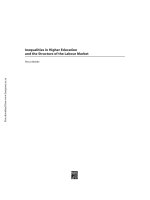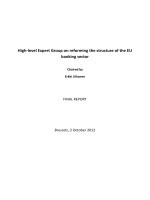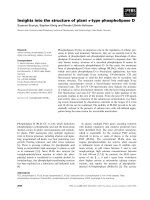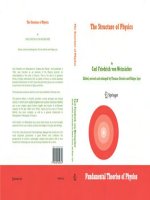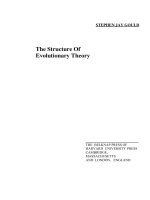- Trang chủ >>
- Khoa Học Tự Nhiên >>
- Vật lý
the structure of scientific revolutions 3rd ed - thomas kuhn
Bạn đang xem bản rút gọn của tài liệu. Xem và tải ngay bản đầy đủ của tài liệu tại đây (26.83 MB, 227 trang )
The
Structure
of
Scientific
Revolutions
,i*'n'*'ipffiii,ll
r\
;,L;'
"
\1*
"
ou;#,
*,7,,/
{^dyl
,hryP
45-
itn
je{
ffiln,t+
l' <d{n\
szr
r
q(t
?
)-Lr,
|
+?,"
\.
i'
J
ttue
s^ct
*{L,
yfrlyg
n,.,
S.
Kuhn
The
Structure
of
Scienti
fic
Revol
utions
Third
Edition
The
University
of
Chicago Press
Chicago
and Lordon
The University
of
Chicago
Press,
Chicago
60637
The University
of
Chicago
Press, Ltd.,
London
@ 1962,1970,
1996 by
The University
of
Chicago
All rights
reserved.
Third edition
1996
Printed
in the United
States
of America
050403020100
345
ISBN: 0-226-45807-5
(cloth)
ISBN
: 0-226-45808-3
(paPer)
Library
of Congress
Cataloging-in-Publication
Data
Kuhn, Thomas
S.
The
structurc
of
scientific
revolutions
/ Thomas
S.
Kuhn.
-
3rd
ed'
p.cm.
Includes
bibliographical
references and
index.
ISBN
0-22645807-5
(cloth
:
alk.
paper)' ISBN
0-22645808-3
(pbk'
: alk'paper)
L science Philosophy.
2. Science History.
I. Title.
Ql7s.K95
1996
501-dc20
96-13195
CIP
@
fhe
paper
used
in this
publication meets
the minimum
requirements
of
the
American
National
Standard
for Information
Sciences-Permanence
of Paper
for
Printed
Library
Materials,
ANSI 239.48-1992.
Contents
Preface vii
I. Introduction: A
Role for
History I
U. The Route
to Normal
Science
I0
m. The Nature
of
Normal Science 23
fV. Normal Science as Puzzle-solving 35
V. The Priority of
Paradigms 43
VI.
Anomaly and the Emergence of Scientific Discoveries
52
VII.
Crisis and the Emergence
of Scientific Theories 66
Vm. The
Response
to Crisis 77
I)(. The Nature and Necessity
of Scientific Revolutions 92
X. Revolutions as Changes of World
View I I I
XI. The Invisibility of Revolutions
136
)(II. The Resolutions of Revolutions
144
)(III. Progress through Revolutions
160
Postscript-1969
174
Index 2I I
The essay that
follows is the first
full published
report on
a
project originally
conceived
almost
fffteen
years
ago.
At that
time
I was
a graduate
student in
theoretical
physics
already
within
sight
of
the end
of
my
dissertation. A fortunate
involve-
ment
with
an
experimental
college
course
treating
physical
science for
the
non-scientist
provided my ffrst exposure to
the
history of
science.
To
my complete
suqprise, that
exposure to
out-of-date
scientiffc
theory
and
practice
radically
undermined
some of
my
basic conceptions
about the nature of
science
and
the reasons
for
its special
success.
Those
conceptions
were ones
I had
previously drawn
partly
from
scientiffc
training itself
and
partly from a
long-standing
avocational
interest
in
the
philosophy
of
science.
Somehow,
whatever
their
pedagogic
utility
and
their
abstract
plausibility,
those notions
did not
at
all fft
the
enterprise
that historical
study
displayed.
Yet
they
were
and are
fundamental
to
many
dii-
cussions
of science,
and
their failures
of verisimilitude
therefore
seemed
thoroughly
worth
pursuing.
The result
was a
drastic
shift in
my_ career
plans, a
shift
from
physics to history
of
sci-
ence
and
then,
gradually, from
relatively
straightforward
his-
torical
problems
back to the
more
philosophical
concerns
that
had
initially
led
me to
history.
Except
foi
a few
articles,
this
essay
is
the ff-rst
of my
published
works
in
which
these
early
concerns
are dominant.In_some
part
it
is an
attempt
to explain
to
myself
and_
to friends
how
I
happened
to
be
dt"*tt
ito*
science
to its history
in
the first
place.
- Yr
fi1st
opportunity
to
pursue in
depth
some
of
the ideas
set
forth
below
was
provided
by
three
y"atr
as a
Junior
Fellow
of
the
society of
Fellows
of
Harvard
uttiversity.
without
that
period
of
freedom
ihe
transition
to
a
new
ffeld
of
study
would
have
been far
more
difficult
and
might
not
have
been
alhieved.
Part
of
!/
time
in those
years
was
devoted
to
history
of
science
proper.
In
particular
I
continued
to
study
the
writings
of
Alex-
Yll
Prefoce
andre Koyr6 and ffrst encountered those
of Emile
Meyerson,
H6ldne Metzger,
and
Anneliese Maier.r
More
clearly
than most
other recent scholars,
this
group has
shown what
it was
like
to
think scientiffcally in a
period
when the
canons
of scientiffc
thought
were very
different from
those
current
today. Though
I
increasingly
question
a few of their
particular
historical
inter-
pretations,
their
works, together
with A. O.
Loveioy's
Great
Chain
of
Being,
have been second only to primary
source
ma-
terials in
shaping my conception of
what the history of scientiffc
ideas can be.
Much of
my
time
in those
years,
however, was spent
explor-
ing
fields
without apparent
relation
to history of science but
in
which
research
now
discloses
problems
like the
ones
history
was
bringing
to my
attention.
A
footnote encountered by
chance
led me to the experiments by
which
Jean
Piaget has
illuminated
both
the
various worlds of
the growing
child and the
process
of transition
from
one
to
the
next.2
One of
my
colleagues
set me
to
reading
papers
in the
psychology
of
perception, particularly
the Gestalt
psychologists;
another introduced
me to B. L.
Whorf's speculations
about the effect of
language
on world
view; and
W. V. O.
Quine
opened for
me
the
philosophical
puzzles
of the analytic-synthetic
distinction.s
That is the
sort of
random
exploration that
the
Society
of
Fellows
permits, and
only through
it
could
I have
encountered Ludwik Fleck's
almost
unknown monograph, Entstehung und. Entu;icklung
einer usis-
1
Particularly
infuential
were Alexandre Koyr6, Etud.es
Galll4ennes
(8
raols.;
Paris, 1939); Emile Meyerson, Identity
ard
Reality,
trans.
Kate
Loewenberg
(
New
York,
1980
);
H6l0ne Metzger, Lei
dnarines chlmiqtns
en
Frarrce du
illbit
du
XVlle d
la
fin
du
)(Vllle
stdcle
(Pans,
1923), and
Nerotoa,
Stalil,
Boeilwaoe
a Ia
doailrc
chimiquc
(Paris,
1930); and
Anneliese Maier,
Db
Vorhufet
GaIh
Leis im
74.
Iahrhutderf
("Studien
zur
Nahrrphilosophie der Spltscholastik";
Rome, f949).
2
Because
they
&splayed concepts
and
processes that also emerge
directly from
the history of
science, two
sets
of Piaget's
investigations proved
particularly
im-
portant: ihe
Childs Cotrceptbn of C"ausotity,
Ea"ns. Mar'j,orie
Cibain
(Loidoru
1930), and
Les rwtions de moutsement
et
de oltesse
clvzfenlont
(Paris,
f946).
8
Whorfs papers have since
been
collected
by
John
B.
Carroll,
Langtnge,
Thouglt, atd, Realitg-Seleaed
Wfitings
of
Beniaiin
Lee
Wlwt
(New-Yoik,
f
956).
Quine
has
presented
his
views in
"Two
Dogmas of Empiricisrn," reprinted
in
his
From
a
Logical
Pokrt ol
Viruu:
(Cambridge,
Mass., l95g),
pp.
20-,1O.
Yiii
Preloce
settsclwftlichen
Tatsache
(Basel,
1935),
an
essay
that antici-
ences
to either
these works
or
conversations
below,
I
am
debted to
them
in more ways
than I can
now
reconstruct
or
evaluate.
During my last
year
as
a
Junior
Fellow,
an
invitation
to
lec-
ture
for
the Lowell Institute
in
Boston provided
a
first
chance
to
try
out my
still developing
notion
of
science.
The
result
was
a
series
of
eight
publie
lectures, delivered
during
March,
1951,
on
"The
Quest
for
Physical
Theory." h
the
next
year
I began
to
teach
history
of
science
proper,
and for almost a decade
the
problems
of
instructing in
a field I had never systematically
studied
left little
time for
explicit articulation
of
the
ideas that
had
first
brought
me
to it.
Fortunately,
however,
those ideas
proved
a
source of
implicit
orientation and
of
some problem-
structure for much of my
more
advanced
teaching.
I
therefore
have
my students to
thank
for invaluable lessons
both about
the
viability
of
my views
and about
the techniques appropriate
to
their effective
communieation. The same
problems
and
orien-
tation
give
unity
to
most
of the
dominantly historical, and ap-
parently
diverse, studies
I have
published
since the
end
of my
fellowship.
Several of them
deal
with
the
integral
part played
by one or
another
metaphysic in
creative scientific
research.
Others examine the way
in which the
experimental
bases of
a
new
theory arc accumulated
and
assimilated
by men
committed
to
an
incompatible
older
theory. In the
process
they
describe
the type
of
development
that I
have
below
called the
"emer-
gence"
of
a
new theory
or
discovery.
There
are
other
such ties
besides.
The ffnal
stage
in the
development
of
this
essay
began
with
an
invitation
to
spend
the
yeir
1958-59
at the
cinter
for
Advanced
studies in the
Behavioral
sciences.
once again
I was
able
to
give undivided
attention
to the
problems
discussed
below.
Even more
important,
spending
the
year
in
a community
tx
Prefoce
composed
predominantly
of social
scientists
confronted me
with
unanticipated
problems
about the
differences between
such
communities
and
those
of
the
natural
scientists
among
whom
I had
been
trained.
Particularly,
I was struck
by
the
number
and
extent
of the
overt
disagreements
between
social
scientists
about
the nature
of legitimate
scientific
problems and
methods.
Both
history
and acquaintance
made
me
doubt
that
practitioners
of the
natural
sciences
possess firmer
or more
perm_anent
answers
to
such
questions
than
their
colleagues
in
social
science.
Yet,
somehow,
the
practice of
astronomy,
physics,
chemistry,
or
biology
normally
fails to
evoke the
controversies
time
provide
model
problems
and
solutions to
a
community
of
practitioners.
Onee
that
piece
of my
puzzle
fell into
place, a
draft
of this
essay
emerged
rapidly.
The
subsequent
history
of that
draft need not
be
recounted
here,
but
a few
words
must
be said about the form
that
it has
preserved
through
revisions.
Until
a ffrst
version had
been com-
much
indebted
to them,
particularly to Charles
Morris,
for
wielding
the
essential
goad
and for advising
me
about
the
an essay rather
than
the full-scale
book my
subiect
will
ulti-
mately
demand.
Since
my
most
fundamental
obiective
is
to
urge
a change
in
x
Prefoce
the
perception
and evaluation
of familiar
data,
the schematic
character of this
first
presentation
need be
no
drawback.
On
the
contrary,
readers whose own research has
prepared
them
for the
sort
of reorientation here advocated
may
find
the essay
form
both more suggestive and
easier to assimilate.
But it
has
dis-
advantages
as well, and
these
may
iustify
^y illustrating at
the
very
start the sorts of extension
in
both
scope
and
depth
that I
hope ultimately to include in a longer version.
Far more
histori-
cal
evidence
is
available
than I have had space
to exploit
below.
Furthermore, that evidence comes from
the history of biological
as well as of
physical
science.
My
decision
to deal
here
exclu-
sively
with the latter
was made
partly
to
increase
this
essay's
coherence and
partly
on grounds
of
present
competence.
In
addition,
the
view of science to be
developed
here suggests
the
potential
fruitfulness
of a
number
of new sorts of
research,
both
historical
and sociological. For example,
the manner in which
anomalies, or violations of
expectation,
attract the
increasing
attention of a scientiffc community needs detailed
study, as
does
the emergence
of
the
crises that may be
induced
by re-
peated failure to make
an anomaly conform. Or again,
if
I
am
right
that
each
scientific revolution
alters
the historical
perspec-
tive
of
the community that experiences it,
then
that
change
of
perspective
should afrect
the structure
of postrevolutionary
textbooks
and
research
publications.
One such effect-a
shift
in
the
distribution of the technical
literature
cited
in
the
footnotes
to research
reports-ought
to
be studied
as a
possible
index
to
the occurrence
of
revolutions.
The need
for
drastic condensation has also forced
me to
fore-
go discussion of a number
of maior
problems.
My
distinction
between
the
pre-
and the
post-paradigm
periods in the
develop-
ment of
a science is, for
example, much
too
schematic.
Each
of
the schools
whose competition
characterizes
the
earlier
period
is guided
by something much
like
a
paradigm; there
are circum-
stances, though I think
them rare,
under
which
two
paradigms
can
coexist
peacefully
in
the later
period.
Mere
possession
of a
paradigm
is not
quite a sufficient
criterion
for the
develop-
mental transition discussed
in
Section II. More
important,
ex-
xl
Prefoce
cept in occasional
brief asides, I
have said
nothing about
the
role
of technological
advance or of external
social, economic,
and
intellectual
conditions in
the
development
of
the sciences.
One
need, however,
look no
further
than Copernicus and
the
calendar to
discover that external
conditions
may help to
trans-
form
a
mere
anomaly into
a source of acute crisis. The same
example would
illustrate
the way
in which
conditions outside
the
sciences may influence
the range of alternatives
available to
the man who
seeks
to
end
a crisis by proposing one or another
revolutionary
reform.r
Explicit
consideration of
effects
like
these
would not, I think, modify
the
main
theses
developed in
this
essay, but
it
would
zurely
add
an
analytic
dimension of
ffrst-rate
importance for
the understanding of
scientific
advance.
Finally,
and perhaps
most
important
of all, limitations of
space
have drastically affected
my
treatment
of the philosoph-
ical
implications
of
this essay's historically
oriented view
of
science.
Clearly,
there
are
such implications,
and
I
have
tried
both
to point out and
to
document
the
main ones.
But
in
doing
so I
have usually refrained
from
detailed
discussion
of
the
various
positions
taken
by contemporary
philosophers
on
the
corresponding issues.
Where I have
indicated
skepticism, it
has
more
often been directed to a
philosophical attitude
than
to
any one of its
fully
articulated
expressions.
As
a result,
some
of
those
who
know and
work within one of trhose
articulated
posi-
tions
may
feel
that
I
have missed their
point.
I
think they
will
be wrong, but this
essay
is
not
calculated
to convince them.
To
attempt that
would
have required
a
far
longer and
very
different
sort of book.
The autobiographical
fragments
with
which
this
preface
r
These
factors
are discussed in
T.
S.
Kuhn,
The CopemlcanReoohnbn:
Phtp-
y
Astronomg in
the
Deoelopment_of Westen firougl*
(Cambridge,
Mass.,
tury AfiotwmV in
the
Deoelopment of Western flwugl*
(Cambridge,
Mass.,
1957),
pp.
12?-32,
27|.l-^71. Other effects of external
intellectual
and-economic
cundifio-ni upon
substantive
scientiffc
development are illustrated
in mv
DaDers.
condiuons upon
evelopment are illusEated
in mv
Daners.
rle of Simultaneous
Discovery," er*;bol
condiuorxr upon
substaDtive
scieDtrtrc
development are ruusrated
in my
Dalrers.
"Consenratioln
of Energy as an Example of Simultaneous
Discovery," er*;/lcol
koblemt lnthe HMor{'ol Science,
ed trlarshall Clagett
(Madison,liris.,
lg59),
koblems ln the Hfrtory of Science,
ed. Marshall Clagett
(
Madison,
pp.
821-5-6;
"E-ngineering
kecedent for the
Work
o{
Sadi Carnot,'
pp.
821-56;
"Engineering
Precedent for the
Work
o[
Sadi Carnot,"
Archloes
l*
tenatUnules thi*oire d,as
ccbtwes,
XIII
(
1960), 247-5li and
'Sadi
Carnot
and
the Cagnard Engine,"
Isis,
LII
(
196l
),
567:l4.It
is,
therefore,
only with
lespect
to
the problens iliscussed in tl'is essay that I take
the
role
of externil
factors t6 be
rninor.
xii
Prefoce
opens will serve to
acknowledge what
I
can
recognize
of
my
main
debt both
to
the works of scholarship
and to the instihr-
tions that
have
helped give
form to my thought.
the
remainder
of that debt I shall
try to
discharge
by
citation
in the
pages
that
follow.
Nothing
said above or below, however,
will more
than
hint at the
number
and
nature
of
my
personal
obligations
to the
many individuals whose suggestions and
criticisms have
at
one
time
or another
sustained and
directed
my
intellectual
develop-
ment. Too much
time
has elapsed since
the
ideas in this essay
began
to
take
shape; a list of
all
those who
may
properly
ffnd
some
signs
of
their infuence in its
pages
would be almost
co-
extensive
with a list
of my friends and acquaintances.
Under
the circumstances,
I must
restrict
myseU to
the few most
signif-
icant infuences
that even a faulty
memory
will never entirely
suPPress.
It
was
|ames
B. Conant, trhen
president of Harvard Univer-
sity, who ffrst
introduced
me
to the history of
science
and thus
initiated the
transformation in my
conception
of
the nature of
scientiffc
advance. Ever
since
that
process
began, he has
been
generous of his ideas,
criticisms,
and
time-including the time
required
to
read
and
suggest important
changes
in
the draft of
my manuscript. Leonard
K. Nash,
with whom
for ffve years
I
taught the historically
oriented
c€urse
that
Dr. Conant had
started,
was an even
more
active
collaborator during the
years
when my
ideas ffrst
began to
take shape,
and
he
has
been
much
missed during the later
stages
of
their development. Fortunate-
ly, however,
after my
departure
from
Cambridge,
his place as
creative
sounding board and
more
was assumed
by my Berkeley
colleague,
Stanley Cavell.
That
Cavell,
a
philosopher
mainly
concerned with
ethics and
aesthetics,
should
have reached
con-
clusions quite so
congruent to
my own
has
been
a constant
source
of
stimulation and
enoouragement
to me.
He is, further-
more, the only
person with whom
I
have
ever
been
able to
ex-
plore my ideas in incomplete
sentences.
That
mode of
com-
munication
attests an
understanding
that
has
enabled
him to
point
me the
way
through
or around
several
maior
barriers
en-
courtered while
preparing my
first manuscript.
xill
Prefoce
Since
that
version was drafted, many
other
friends have
helped
with
its
reformulation.
They will,
I think, forgive me if
I
name
only
the four
whose
contributions proved most
far-
reaching
and decisive: Paul K. Feyerabend of
Berkeley, Ernest
Nagel
of
Columbia,
H. Pierre
Noyes of the
Lawrence
Radiation
Laborator/,
and my student,
John
L. Heilbron,
who has
often
worked
closely with
me
in
preparing
a ffnal version
for
the
press.
I have
found all their reservations
and suggestions extremely
helpful,
but
I
have
no
reason
to
believe
(and
some
reason
to
doubt)
that
either they or
the
others mentioned
above approve
in its
entirety the
manuscript that
results.
My ffnal
acknowledgments,
to my parents,
wife, and
children,
must
be
of
a
rather different
sort.
In
ways
which I
shall prob-
ably be
the
last
to
recognize,
each of them, too, has
contributed
intellectual ingredients
to my
work. But
they
have also,
in vary-
ing degrees,
done something more important.
They have, that
is,
let
it
go
on
and
even
encouraged
my
devotion to it.
Anyone
who has
wrestled with a
project
like mine
will recognize
what
it
has
occasionally
cost them. I do not
know how
to
give
them
thanks.
T.
S.
K.
lBxlrrr.gv, Cer.rronxr.l
February 1962
xtY
l. Introduclion;
A
Role
for History
from
which
each
new
scientiffc
generation
leams
to practice
its
trade.
Inevitably,
however,
the aim
of such
books
is
persuasive
and pedagogc;
a concept
of
science
drawn
fiom
them is no
more likely
to fft
the enteqprise
that
produced
them than
an
image
of a
national culture drawn
from a
tourist brochure
or
a
language text.
This
essay attempts
to
show
that
we have been
misled by
them in
fundamental ways. Its aim
is
a
sketch
of the
quite
different
concept
of science that
can
emerge
from the
historical
record of the research activity
itseU.
Even
from
history,
however, trhat new concept will
not
be
forthcoming
if
historical data continue
to be
sought and
scruti-
nized
mainly to answer questions posed
by the unhistorical
stereotype
drawn
from
science
texts.
Those texts have, for
example,
often
seemed
to
imply
that the content
of
science
is
uniquely
exemplified by
the observations, laws,
and theories
described
in
their pages.
Almost
as regularly,
the
same
books
have
been
read
as
saying that
scientific
methods are
simply the
ones illustrated
by the manipulative
techniques used in gather-
ing
textbook
data, together with
the
logical
operations em-
ployed
when relating those
data
to the
textbook's theoretical
generalizations.
The result has
been
a concept of science with
profound
implications
about its nature
and development.
If science
is
the constellation of facts,
theories,
and
methods
collected
in current texts,
then
scientists
are the men
who, suc-
cessfully
or not,
have
striven
to contribute one
or another
ele-
ment
to
that
particular cunstellation.
Scientiffc
development
be-
comes the piecemeal process by which these
items
have been
fhe
Sfrucfure
of Scientific
Revofutions
added, singly and
in
combination,
to the
ever
growing
stockpile
that constitutes scientific technique
and knowledge.
And
history
of science becomes the
discipline
that
chronicles both
these
successive increments
and
the obstacles
that have inhibited
their accumulation.
Concerned
with
scientiffc development,
the
historian then appears
to
have two
main tasks. On
the
one
hand,
he
must
determine by
what man
and
at
what point
in
time
each
contemporary scientiffc
fact, law, and theory
was discovered
or
invented.
On
the other, he
must deseribe
and explain
the con-
geries of error, myth, and
superstition
that
have inhibited
the
more rapid accumulation
of
the
constituents
of
the modern
science
text.
Much
research has
been
directed
to
these
ends,
and
some still is.
In
recent
years,
however, a few
historians of
science
have
been
finding it
more
and more
difficult
to fulffl the functions
that
the
concept
of development-by-accumulation
assigns
to
them.
As
chroniclers
of
an
incremental
proctss,
they discover
that additional
research makes it
harder, not easier, to
answer
questions
like:
When
was
oxygen discovered?
Who
first con-
ceived
of energy conservation?
Increasingly,
a
few of them
sus-
pect
that
these are
simply
the
wrong
sorts
of
questions
to
ask.
Perhaps
science does
not
develop
by the
accumulation of
indi-
vidual discoveries
and inventions. Simultaneously,
these
same
historians
confront
growing
difffculties
in distinguishing
the
"scientific"
component
of
past
observation
and
belief
from
what
their
predecessors
had readily labeled
"elTor"
and
"supersti-
tion." The more carefully they
study,
say, Aristotelian dynamics,
phlogistic
chemistry,
or
caloric
thermodynamics,
the
more cer-
tain they
feel that
those
once current views
of nature were, as a
whole,
neither less scientific nor
more
the
product
of human
idiosyncrasy
than those
current today. If
these
out-of-date
be-
liefs are
to
be called
myths, then myths can
be
produced
by the
same
sorts
of methods
and
held
for
the
same
sorts of reasons
that now lead
to
scientific
knowledge. If,
on
the other
hand,
they trre
to be called
science,
then
science has included
bodies
of belief quite
incompatible
with the ones
we
hold today. Given
these
alternatives,
the
historian
must choose
the
latter.
Out-of-
2
lnlroduction:
A
Role
for
HistorY
date
theories
are
not
in
principle
unscientific
becaury
tley
have
been
discarded.
That
c[oice,
however,
makes
it difficult
to see
scientific
development
as
a
Process
of
accretion.
The
same
his-
torical
research
that
displays
the difficulties
in isolating
indi-
vidual
inventions
and
discoveries
gives
ground
for
profound
doubts
about
the
cumulative
process
through
which
these
indi-
vidual contributions
to science
were
thought
to have
been
com-
pounded.
-
The
result
of all
these doubts
and difficulties
is a
historio-
graphic
revolution
in the
study
of
scie_nce,
though
one
that
js
ititl
i.t its early
stages.
Gradually,
and
often
without
entirely
realizing
they
are
doing
so,
historians
of
science
hav-e
b-egun
to
ask
new-sorts
of questions
and
to
trace
different,
and often
less
than
cumulative,
developmental
lines
for
the
sciences.
Rather
than
seeking
the
Permanent
contributions
of
an
older
science
to
dur present
vantage,
they
attempt
to
display
the
historical
in-
tegrily
of that
science
in
its
own
time. They
ask,
for
-example,
no"t
a'bout
the
relation
of
Galileo's
views
to those
of
modern
science,
but
rather
about
the
relationship
between
his
views
and
those
of
his
group,
i.e.,
his teachers,
contemporaries,
and
imme-
diate
srrccesiots
in
the
sciences.
Furthermore,
they
insist uPon
studying
the
opinions
of
that grouP
""q
other
similar
ones
from
ttte
"ieripointlusually
very
difierent
from that
of modern
sci-
en
ce-th
at gives
thos
e opinion
s th e
m
aximum
intern
al-cnh
erp-Bgll-
and
the
clJsest
possible
fit
to
nature.
Seen
through
the
works
that
result,
worfs perhaps
best
exemplified
in the
writings
of
Ale&pdre_K'g6,
icience
does
not seem
altogether
the
same
enteryrise
as
tie
one
discussed
by
writers
in the
older historio-
g.uplii"
tradition.
By
implication,
at
least,
these
historical
Jt,tii"r
suggest
the possibility
of a
new
image
of
science.
This
essay
aims"fo
delineate
that
image
by
making
explicit
some
of
the
new
historiography's
implications.
What
aspects
of
science
will
emerge
!o
prgminence
in
the
course
of
this
eflort?
First,
at
least
in order
of presentation,
is
theinsuffi
ciencyof
qtrSgdgJ-o-g,ry-e$g9S!ry9t-bythemselves,to
.+ L
a*-*'
''"Y_'
dic@stantive
conclusion
to
many
sorts of scien-
tific questionJ.
Instructed
to examine
electrical
or
chemical
Ph"-
The
Sfruclure
ol Scienliffc Revolutions
nomena,
the
man who
is ignorant
of
these
ffelds
but who
knows
what
it is
to be scientiftc
may legitimately
reach any one
of
a
,
number
of incompatible
conclusions. Among those legitimate
J
possibilities, the
particular
conclusions he
does arrive
at
are
/
probably determined
by
his
prior experience
in other ffelds,
by
I
the accidents
of his investigation,
and by his own individual
makeup.
What beliefs about
the
stars,
for
example,
does he
bring to the study
of chemistry
or
electricity?
Which
of
the
many
conceivable experiments
relevant
to
the
new ffeld
does
he
elect
to
perform ffrstP
And
what aspects of
the
complex
phenom-
enon
that then results
strike
him
as particularly relevant to an
elucidation
of
the
nature
of chemical
change or of
electrical
affinity? For
the individual,
at
least,
and sometimes
for the
scientific community
as well,
answers
to questions like
these
are
i of
scientiffc
development.
We
shall
rn II
that the early
developmental
re been characterized
by
continual
ber of distinct
views of
nature, each
rll roughly
compatible
with, the
dic-
rn
and
method.
What
differentiated
these
various
schools
was not
one
or another
failure
of method-
they
were
all
"scientiffc"-but
what we
shall come to
call their
incommensurable
ways
of
seeing the
world and
of
practicing
science in
it. Observation
and
experience
can and
must
drasti-
cally restrict
the range
of
admissible
scientiftc
belief,
else there
would be
no
science.
But
they cannot
alone
determine
a
par-
ticular bo_dy
of
such
belief. An
apparently
arbitrary
element,
compounded
of_personal
and historical
accident,
ii
always
a
formative
ingredient
of the
beliefs
espoused
by
. given scien-
tific
community
at a
given
time.
That
element of
arbitrariness
does not,
however,
indicate
that
any
scientiffc
group
could
practice its
trade
without
some
set of
received
beliefs.
Nor
does it make
less
consequential
the
par-
ticular
constellation
to which
the group,
at
a given
time,
ii
in
fact committed.
Effective
reseatch
scarcely
Legins
before
a
scientific
community thinks
it has
acquired
ffrm
answers
to
questions
like
the
following:
What
are
the fundamental
entities
1
Introduction:
A
Role
for History
of
which the
universe
is composed?
How do
these
interact
with
each other
and with the
senses?
What
questions
may
legitimate-
ly be asked about
such entities
and
what
techniques
employed
in
seeking
solutions?
At least
in
the
mature
sciences'
answers
(or
full iubstitutes
for answers)
to questions
like
these
are
ffrmly embedded in
the educational
initiation
that
prepares
and
Iicenies the
student
for professional
practice.
Because
that
edu-
historic
origins
and, occasionally,
in
their
subsequent
develop-
ment.
Yet
that element
of
arbitrariness
is present,
and
it too
has an
important
effect on
scientific
development,
one
which
will be
examined
in
detail
in
Sections
VI, VII,
and
VI[.
Normal
sci-
novelties
because
they
are
necessarily
subversive
of
its
basic
commitments.
Nevertheless,
so
long as
those
commitments
re-
tain
an
element
of
the arbitrary,
the very
nature
of
normal re-
search
ensures
that novelty
shall not
be
suPPressed
for
very
fhe
Sfructure
of
Scientific Revolutions
to
perform in
the anticipated
manner,
revealing
an
anomaly
that
cannot,
despite
repeated
effort, be
aligned with
profes-
sional
expectation.
In these
and other ways besides,
normal
science repeatedly
goes astray.
And
when it
does-when, that
is,
the
profession
can
no longer
evade anomalies
that
subvert the
existing
tradition
of scientific
practice-then
begin the extraordi-
nary
investigations
that lead
the
profession
at last
to a
new
set
of
commitments,
a
new
basis
for
the
practice
of
science. The
extraordinary
episodes in
which
that shift of
professional com-
mitments
occurs
are
the ones known in this
essav
as
scientific
revolutions.
They are the
tradition-shattering
complements
to
the
tradition-bound
activity of
normal
science]
The most
obvious
examples
of
scientific revolutions
are those
famous
episodes in
scientiftc
development
that have
often
been
labeled
revelutions
before. Therefore,
in
Sections
IX
and
X,
where
the nature
of scientific
revolutions is ffrst
directly
scruti-
nized,
we shall
deal
repeatedly
with the major turning
points
in
scientific
development
associated
with the
names
of
Copernicus,
Newton,
Lavoisier,
and Einstein.
More
clearly
than
most other
episodes
in
the
histoqy
of
at
least
the
physical
sciences,
these
display
what
all scientiftc
revolutions
are
about.
Each of them
necessitated
the
community's
rejection of one
time-honored
scientific
theory
in
favor
of
another incompatible with
it.
Each
produced
a
consequent
shift
in
the problems available for
scien-
tiffc scrutiny
and
in
the standards
by which the
profession de-
termined what
should
count as an
admissible problem or as a
Iegitimate
problem-solution. And each transformed the
scien-
tific
imagination
in
ways that
we shall ultimately
need to
de-
scribe as a
transformation
of
the
world
within which
scientific
work was done. Such
changes,
together
with
the
controversies
that
almost
always
accompany them, are the deffning
character-
istics of scientiftc revolutions.
These
characteristics emerge
with
particular clarity
from
a
study of, say, the Newtonian
or the chemical revolution. It
is,
however, a fundamental thesis
of
this
essay that they can
also
be
retrieved from the study
of
many other
episodes that were
not
so obviously revolutionary. For
the far smaller
professional
6
lnlrodvcliont
A
Role
for
HistorY
an
isolated event.
Nor
are
new inventions
only
scientiftc
events
that
have
revolutionary
impact upon
the
specialists
in
whose
domain
they
occur.
The
commitments
that
govern
normal sci-
ence
specify
not only
what sorts
of entities
the
universe does
contain,
but also,
by implication,
those that
it does
not. It fol-
lows, though the point
will
require extended
discussion,
that a
discovery
like that
of
oxygen or
X-rays does
not simply add
one
more
item to the populatibn
of
the scientist's
world.
Ultimately
it
has
that
efiect, but
not until the
professional
community
has
re-evaluated
traditional
experimental
procedures,
altered
its
conception
of entities
with which
it
has long
been
familiar,
and,
in the process,
shifted
the network of
theory
through which
it
deals with
the world. Scientiffc
fact and
theory arcnot
categori-
cally separable,
except
perhaps within
a
single tradition
of nor-
mal-scientiffc practice.
That is why the
unexpected discovery
is
not simply
factual in its import
and
why the scientist's
world
is
qualitatively
transformed
as
well as
quantitatively
enriched
by
fundamental
novelties
of either fact or
theory.
This
extended conception
of the nature of
scientiffc
revolu-
tions
is
the one delineated
in
the
pages
that
follow. Admittedly
the extension
strains ctrstomary
usage.
Nevertheless, I shall con-
fhe
Struclure
of
Scienliffc
Revolufions
tinue
to
speak
even
of discoveries
as
revolutionary,
because it
is
iust
the
pbssibility
of relating
their
structure
to
that
of, say, the
Copernican
revolution
that
makes
the
extended
conception
seem
to me
so important.
The
preceding discussion indicates
how the
complementary
notions
bf
normal
science
and
of
scien-
revolutionary
competition
between the
proponents
of
the
old
normal-scientific
tradition
and
the
adherents
of
the
new one. It
mies is
available
to
suggest
that
it
cannot
properly
do so.
His-
t_ory,
we too
often
say,
is
a
purely descriptive
discipline.
The
theses
suggested
above
are, however,
often
interpietive
and
8
lntroduction:
A
Role
for
HidorY
tion.' Can
anything
more
than profound
confusion
be
indicated
by
this
admixture
of diverse
ffelds
and
concerns?
Having
been
weaned
intellectually
on
these
distinctions
and
others
[k1 them,
I could
scarcely
be
more
aware
of
their impor!
and
force.
For many years
I took
them
to
be
about
the
nature
of
knowledge,
and
I ;till
suPPose
that, appropriately
recast,
they
have
ronr'"thitrg
importattt
to
tell us.
Yet
my
attempts
to
apply
them, even
grooi
mado,
to the
actual
situations
in
which
knowledge
is gained,
accepted,
and assimilated
have
made
them
seem
extraordinarily
problematic.
Rather
than
being
elementary
logical or methodological
distinctions,
which
would
thus be
priot
to
the analysis
of
scientific
knowledge,
they
now
t"9m
integral
parts
of
a traditional
set of substantive
answers
to
the
very
q,restions
upon
which they
have
been
deployed.
That_
cir-
cularily
does
not at
all
invalidate
them.
But
it does
make
them
parts
of a theory
and, by
doing so,
subiects
them
to the same
icrutiny
regularly
applied
to theories
in other
fields.
If they are
to have
more
than
pure
abstraction
as
trheir
content,
then
that
content
must be
discovered
by
observing
them
in application
to
the
data they are
meant
to
elucidate.
How could
history
of
science
fail
to be
a source
of phenomena
to which
theories
about
knowledge
may
legitimately be asked
to
apply?
ll.
The
Route
lo
Normol
Science
In
this
essay,
'normal
science'means
research
firmly
based
upon
one
or
more
past
scientific
achievements, achievements
that
some
particular scientific
community acknowledges for
a
time as
supplying
the
foundation
for
its
further practice.
Today
such
achievements
are recounted,
though seldom in
their
orig-
inal form,
by
science
textbooks,
elementary and advanced.
These
textbooks
expound
the
body of accepted theory,
illustrate
many
or
all of
its
successful
applications, and compare these
applications
with
exemplary observations and
experiments.
Be-
fore such
books
became
popular early
in the nineteenth
century
(
and
until
even more recently
in the newly matured
sciences
),
many
of
the
famous
classics of
science fulfflled a similar func-
tion.
Aristotle's Physica,
Ptolemy's
Alrnagest, Newton's Prin-
cipia
and Opticks,
Franklin's
Electricity, Lavoisier's
Chemistry,
and
Lyell's
Geolagy-these
and
many
other
works
served
for
a
time implicitly
to
define
the
legitimate
problems and methods
of
a
research
fteld
for
succeeding
generations of
practitioners.
They were
able
to
do
so
because they shared two essential
char-
acteristics.
Their achievement
was sufficiently
unprecedented to
attract
an
enduring
group
of adherents away
from
competing
modes of scientific
activity.
Simultaneously,
it was
sufficiently
open-ended
to leave
all sorts of
problems
for
the redefined
group of practitioners
to resolve.
Achievements
that share
these
two
characteristics
I
shall
henceforth refer
to as'paradigms,'a
term that
relates
closely to
'normal
science.'By
choosing it,
I
mean
to
suggest
that some
accepted examples
of
actual scientific
practice-examples
which
include
law,
theory,
application, and instrumentation
together-
provide
models from
which
spring
particular
coherent
traditions
of scientific research.
These
are the traditions
which
the
his-
torian
describes
under
such rubrics as'Ptolemaic
astronomy'
(or
'Copernic"r'),'Aristotelian
dynamics'
(or'Newtonian'),'cor-
puscular
optics'(or'wave optics'),
and
so
on. The
study
of
l0
fhe Route
fo
Normol
Science
paradigms,
including many
that
are
far
more
specialized
than
those named illustratively
above, is what
mainly
prepares
the
student
for membership in the
particular
scientific
community
with
which he
will later
practice.
Because he
there
joins
men
who learned the
bases
of
their
ffeld
from the
same
concrete
models, his subsequent
practice
will
seldom evoke
overt
dis-
agreement
over
fundamentals.
Men
whose
research
is
based
on
shared
paradigms
are committed
to the
same
rules
and stand-
ards
for
scientific
practice.
That commitment
and
the apparent
consensus it
produces
are
prerequisites
for normal
science,
i.e.,
for
the
genesis
and
continuation
of a
particular
research
tradi-
tion.
Because in this
essay the concept
of a
paradigm
will
often
substitute
for a variety
of familiar
notions,
more
will
need
to
be
said
about
the
reasons for its introduction.
\Mhy
is
the
concrete
scientific
achievement,
as
a
locus of
professional
commitment,
prior
to the various concepts,
Iaws,
theories, and
points
of view
that
may
be abstracted
from
it?
In
what sense
is the
shared
paradigm
a
fundamental unit
for the
student of scientific de-
velopment, a
unit
that
cannot
be
fully
reduced
to
logically
atomic
components which might function
in
its stead?
When
\Me encounter them
in
Section
V,
answers
to
these questions and
to
others
like
them
will
prove
basic
to
an
understanding both
of
normal science and of the associated
concept
of paradigms.
That more abstract
discussion
will depend, however, upon
a
previous
exposure
to
examples
of normal science
or
of para-
digms
in operation. In
particular,
both these
related concepts
will
be clarified by
noting that there
can
be a
sort of scientific
research
without
paradigms,
or
at
least without any
so
un-
equivocal
and
so binding as the
ones named
above.
Acquisition
of
a
paradigm
and of the more esoteric type of
research
it
per-
mits
is
a
sign
of maturity in the
development of any given scien-
tific
field.
If the historian traces the scientific
knowledge of any selected
group
of
related
phenomena
backward in
time,
he is likely
to
encounter some minor variant of a
pattern
here illustrated
from
the history of
physical
optics.
Today's physics
textbooks
tell
the
1l


